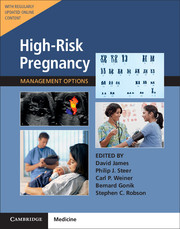Book contents
- Frontmatter
- Contents
- List of Contributors
- Preface
- Section 1 Prepregnancy Problems
- Section 2 Early Prenatal Problems
- Section 3 Late Prenatal – Fetal Problems
- 9 Prenatal Fetal Surveillance
- 10 Fetal Growth Disorders
- 11 Disorders of Amniotic Fluid
- 12 Fetal Hemolytic Disease
- 13 Fetal Thrombocytopenia
- 14 Fetal Cardiac Arrhythmias
- 15 Fetal Cardiac Abnormalities
- 16 Fetal Craniospinal and Facial Abnormalities
- 17 Fetal Genitourinary Abnormalities
- 18 Fetal Gastrointestinal and Abdominal Abnormalities
- 19 Fetal Skeletal Abnormalities
- 20 Fetal Tumors
- 21 Fetal Hydrops
- 22 Fetal Death
- Section 4 Problems Associated with Infection
- Section 5 Late Pregnancy – Maternal Problems
- Section 6 Late Prenatal – Obstetric Problems
- Section 7 Postnatal Problems
- Section 8 Normal Values
- Index
15 - Fetal Cardiac Abnormalities
from Section 3 - Late Prenatal – Fetal Problems
- Frontmatter
- Contents
- List of Contributors
- Preface
- Section 1 Prepregnancy Problems
- Section 2 Early Prenatal Problems
- Section 3 Late Prenatal – Fetal Problems
- 9 Prenatal Fetal Surveillance
- 10 Fetal Growth Disorders
- 11 Disorders of Amniotic Fluid
- 12 Fetal Hemolytic Disease
- 13 Fetal Thrombocytopenia
- 14 Fetal Cardiac Arrhythmias
- 15 Fetal Cardiac Abnormalities
- 16 Fetal Craniospinal and Facial Abnormalities
- 17 Fetal Genitourinary Abnormalities
- 18 Fetal Gastrointestinal and Abdominal Abnormalities
- 19 Fetal Skeletal Abnormalities
- 20 Fetal Tumors
- 21 Fetal Hydrops
- 22 Fetal Death
- Section 4 Problems Associated with Infection
- Section 5 Late Pregnancy – Maternal Problems
- Section 6 Late Prenatal – Obstetric Problems
- Section 7 Postnatal Problems
- Section 8 Normal Values
- Index
Summary
Introduction
The prenatal detection of congenital heart disease or defects (CHD) has improved over the years, though it remains below 50%. Major defects are more readily detectable (57%) than isolated lesions (44%). Given that CHD accounts for nearly one-third of all congenital anomalies, its implications on the neonatal outcome and its financial burden are significant. The incidence of CHD is influenced by the definition of the disease, the associated anomalies, and the timing of diagnosis.
Large population studies have reported an incidence of 8–9 per 1000 live births. However, if anomalies such as bicuspid aortic valve, persistent left superior vena cava, and isolated aneurysm of the atrial septum were included, the incidence of CHD would approach 50 per 1000 births. Isolated ventricular septal defects (VSDs) are the most common CHD, with an incidence of up to 5 per 1000 among newborns. Though the majority of muscular VSDs will close by the first year of life, their identification influences the prevalence of CHD among fetuses and newborns. Moreover, some congenital heart defects are not diagnosed until the first week of life, while the majority will be confirmed by the first year of life (88%) and some not until the fourth year of life (98%). The challenge remains to increase the prenatal detection of CHD and ensure appropriate counseling to the parents and referral to centers with resources to improve the neonatal outcome.
Fetal Cardiac Screening
There are two levels of fetal cardiac ultrasound scanning:
• Fetal cardiac screening (see Chapter 7)
• Fetal echocardiography
Fetal cardiac screening refers to the ultrasound examination of the fetal heart as part of the standard ultrasound examination in the second trimester of pregnancy. Fetal cardiac screening is applied to all pregnancies undergoing an ultrasound examination in the second or third trimester of pregnancy, whereas a fetal echocardiogram is a detailed sonographic evaluation of the fetal heart that is indication-driven and applied to fetuses at increased risk for CHD. The International Society of Ultrasound in Obstetrics and Gynecology (ISUOG) published in 2013 the updated practice guidelines for the sonographic screening of the fetal heart. The guidelines state that fetal cardiac screening is most optimally performed between 18 and 22 weeks’ gestation and should include the upper abdomen, the fourchamber view, and outflow tracts.
- Type
- Chapter
- Information
- High-Risk Pregnancy: Management OptionsFive-Year Institutional Subscription with Online Updates, pp. 341 - 364Publisher: Cambridge University PressFirst published in: 2017



